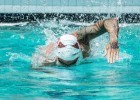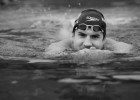3 Reasons to Stretch While Tapering
In order to reduce stiffness and feel ready to compete, you can gently move your muscles through a few stretches. Stretching boosts blood circulation to muscle tissue, helping your body exchange waste products for oxygen and nutrients.
3 Tips for Competition Travel
When athletes travel, external factors in the travel day can be disruptive to their meet preparation. The elite athlete takes steps to minimize any negative impact from traveling—whether or not the day goes as planned. Here are a few tips to help you travel smoothly for a competition.
3 Steps to a More Explosive Relay Start
There are many styles to a relay start. Power and reaction time are critical to all of them. Let’s take a look at the top 3 things you can do to sharpen your relay start.
Travel Meets: 5 Things to Do on Arrival
From the moment you land in a new place for a meet, the rest of your day should follow the same pattern every time you travel—that is to say, what you do on arrival day must become second nature to you.
3 Nutrition Tips for Peak Swimming Performance
How you eat is not about calories, “super foods”, or special tricks. It is entirely about how you can best refuel your muscles for the next race while accelerating recovery from the previous one.
5 Steps to Finish Stronger at Championship Meets
Three full days of racing is incredibly taxing, both mentally and physically. Athletes must learn how to take advantage of the high-energy environment without letting it deplete their own energy stores.
3 Ways to Recover Faster Between Prelims and Finals
Good recovery between prelims and finals sessions at a meet has a huge impact on how you race in finals. The second half of the day demands much more energy, excitement, and, most importantly, mental and physical preparedness.
3 Ways to Stay Healthy in Flu Season
Fall is an important time of year for swimmers as they lay down an aerobic base to build upon for the season ahead. In the midst of competitions and heavy training, athletes need to maximize their health so they can maintain consistency and perform their best.
Glute Activation for Greater Stability in Swimming
Because swimmers over-develop and preferentially activate their quadriceps during lower body exercises, the posterior leg does not respond to resistance as quickly. Over time, this movement pattern becomes habit, and the glutes and hamstrings fail to “turn on” since the quads will automatically absorb the load.
3 Ways to Improve Your Relay Starts in Swimming
Racing in a group of 4 teammates is the closest swimming gets to feeling like a true team sport. In order to succeed, relay members need to not only have flawless starts, but also perfect timing with their teammate’s finish.
3 Ways to Improve your Breath Control
All swimmers can benefit from improving their breath control—whether it helps you hold your head down in the final meters of a race or it enables you to go further underwater off each wall.
3 Ways to Improve Your Kick
Kicking can be your secret weapon if you focus on developing it. Whether it comes naturally to you or not, a strong kick will help you close your races hard.
Swim Training: How to Generate a More Powerful Catch
Building strength through swimming alone can be difficult. With proper strength training on land, and with resistance tools like stretch cords and parachutes in the water, swimmers will increase their power with each stroke.
3 Ways to Get the Most Out of Early Season Training
In the early weeks of a season, there are a few key training elements you should take advantage of. #2 is kicking…a lot. (Stock Featured Image: Charlie Houchin)
The Winning Team’s Mindset
When you’re competing for a team championship, each event contributes points to the team total. Conference meets pack all the events into three-and-a-half days while NCAA’s squeeze everything into three days. (Featured Image: University of Michigan 2013 NCAA Team Title)












